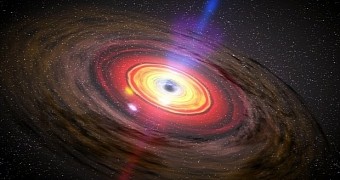A study published earlier this week in the science journal Monthly Notices of the Royal Astronomical Society announces the discovery of a positively humongous black hole at the core of a galaxy dubbed SAGE0536AGN.
This galaxy sits at a distance of about 2 billion light-years from our Solar System. It was discovered back in 2011 by scientists sifting through data delivered by NASA's Spitzer Space Telescope and is estimated to have formed around 9 billion years ago.
The black hole is too big for its galaxy
At a first glance, SAGE0536AGN looks just like any other galaxy. Still, scientists with the Royal Astronomical Society have reasons to believe it might be the first of a previously undocumented class.
This is because, by the looks of it, the black hole at its core is way bigger than it should be, at least according to current theories of galactic evolution.
SAGE0536AGN is estimated to hold the mass equivalent of 25 billion Suns. Usually, galaxies this size accommodate for black holes that pack the equivalent of approximately 12 million solar masses.
The black hole at the heart of SAGE0536AGN, however, appears to weigh in at about 350 million solar masses, making it 30 times bigger than it should be.
“Galaxies have a vast mass, and so do the black holes at their cores. This one through is really too big for its boots - it simply shouldn't be possible for it to be so large,” says researcher Jacco van Loon.
Scientists have never seen anything like it
Study leader Jacco van Loon and his team admit that SAGE0536AGN is the first galaxy found to hide a black hole so abnormally big when compared to its size.
In fact, as mentioned, the researchers are seriously thinking that this galaxy might be the first in a new and quite peculiar class of galaxies that hasn't been documented yet.
As for why the black hole is as big as it is when compared to its home galaxy, the scientists think this is because, at some point, SAGE0536AGN stopped growing or at least grew at a slower pace while the black hole went on to gorge on material and so got bigger and bigger.
Usually, galaxies and the black holes in their center grow at about the same rate, astrophysicist Jacco van Loon and fellow researchers explain.

 14 DAY TRIAL //
14 DAY TRIAL //